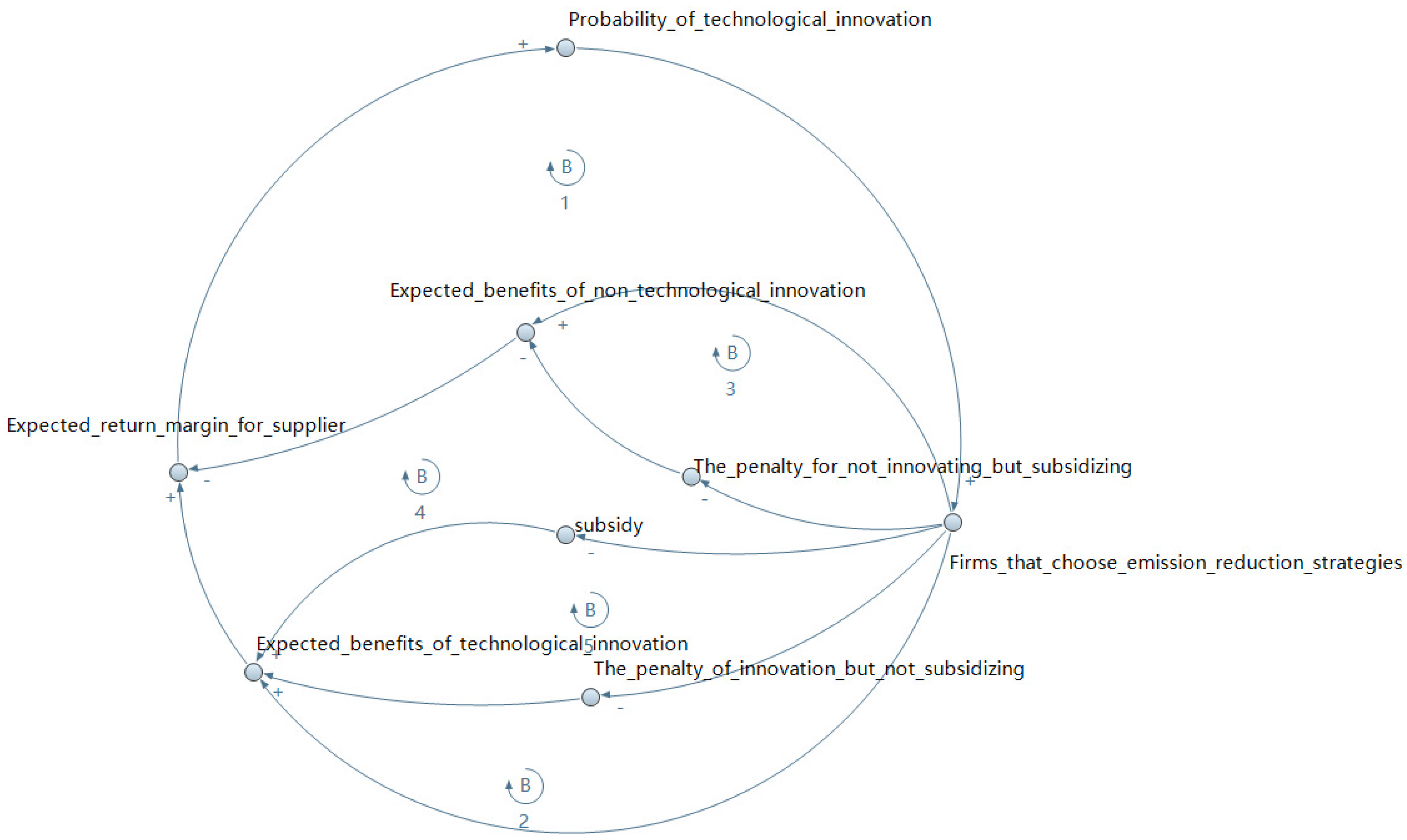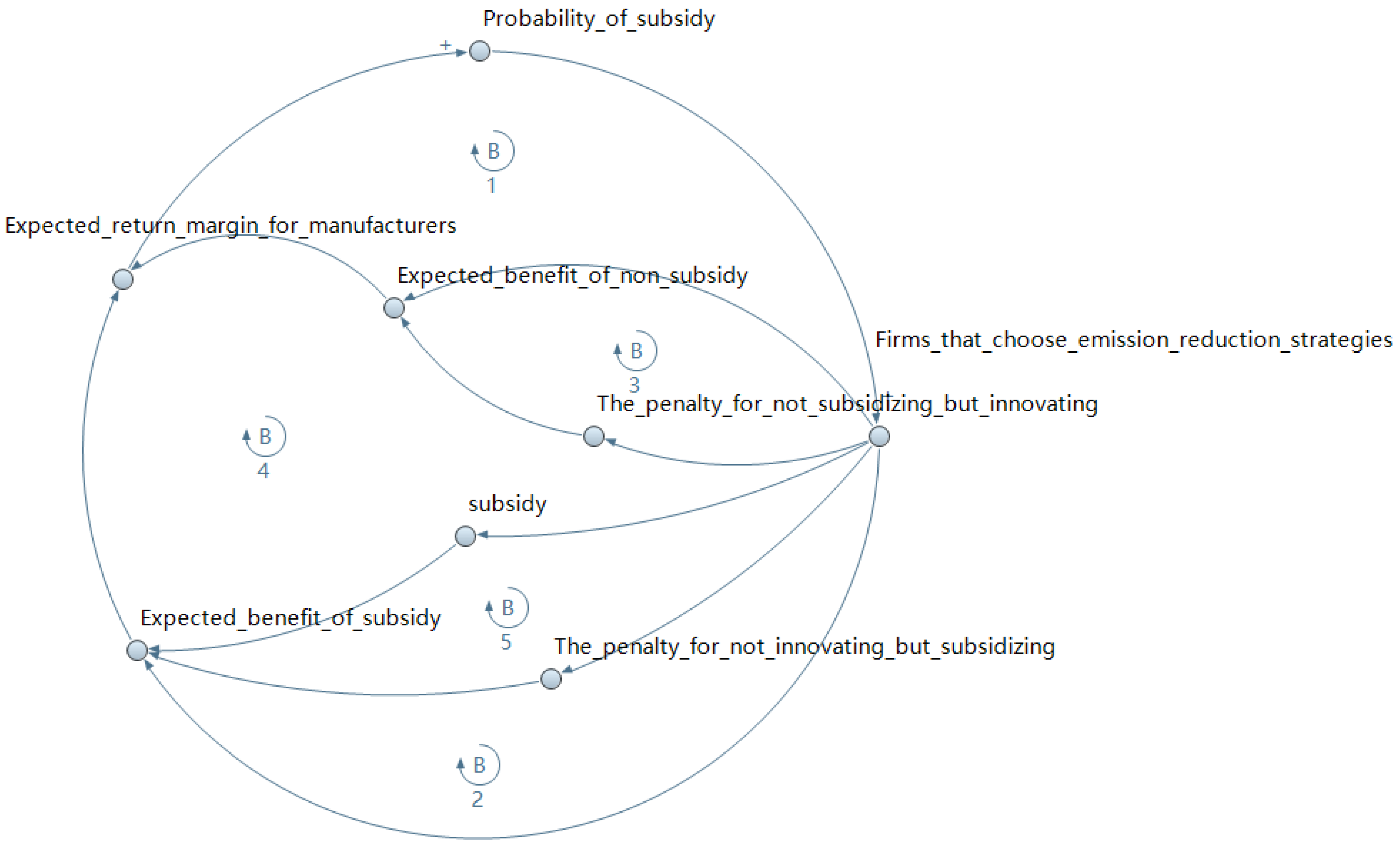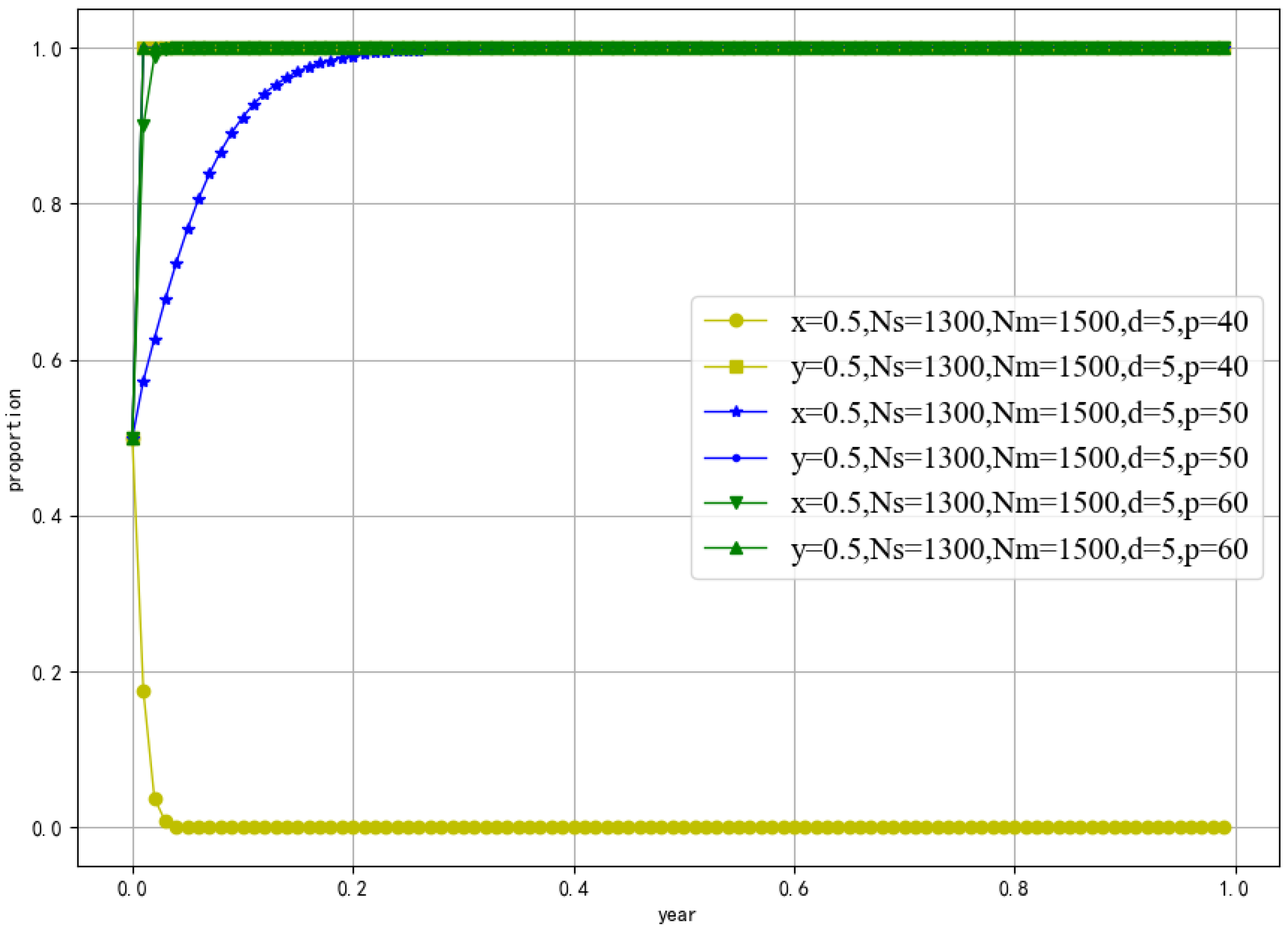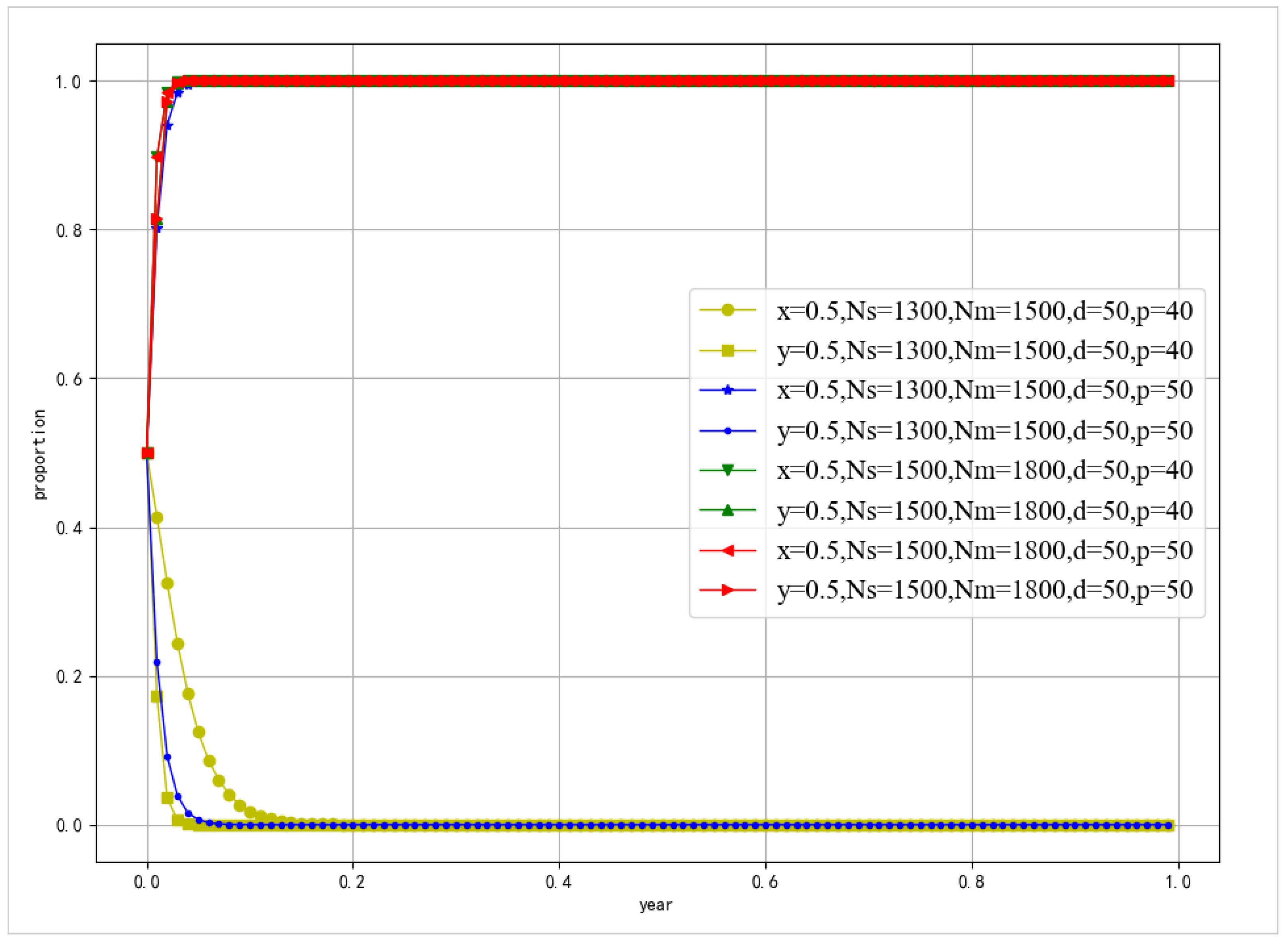Evolutionary Game and Strategy Analysis of Carbon Emission Reduction in Supply Chain Based on System Dynamic Model
Abstract
:1. Introduction
2. Literature Review
2.1. Theoretical Basis
Carbon Emissions Trading
2.2. Research Method
2.3. Brief Summary
3. Models and Assumptions
3.1. Evolutionary Game Model Construction
3.2. Cause-and-Effect Loop Diagram
3.2.1. Supplier Technology Innovation Strategy Sub-System
3.2.2. Manufacturer Subsidy Strategy Sub-System
3.3. Stock Flow Diagram
4. Data Simulation and Analysis
4.1. The Impact of Carbon Prices on Corporate Decisions to Reduce Emissions
4.2. Impact of Penalty Strategies on Firms’ Emission Reduction Decisions
4.3. The Impact of Subsidy Strategy on Enterprises’ Emission Reduction Decisions
5. Discussion
5.1. Incentive Policies for Technological Innovation in the Context of Carbon Trading
5.2. Coordinate the Innovation of Supply Chain Enterprises
6. Concluding Remarks
Author Contributions
Funding
Data Availability Statement
Conflicts of Interest
References
- Pan, X.; Pu, C.; Yuan, S.; Xu, H.T. Effect of Chinese pilots carbon emission trading scheme on enterprises’ total factor productivity: The moderating role of government participation and carbon trading market efficiency. J. Environ. Manag. 2022, 316, 115228. [Google Scholar] [CrossRef]
- Wang, K.H.; Liu, L.; Zhong, Y.; Lobont, O.R. Economic policy uncertainty and carbon emission trading market: A China’s perspective. Energy Econ. 2022, 115, 106342. [Google Scholar] [CrossRef]
- Chen, J.; Gui, W.Y. The impact of the establishment of carbon emission trade exchange on carbon emission efficiency. Environ. Sci. Pollut. Res. Int. 2023, 30, 19845–19859. [Google Scholar] [CrossRef] [PubMed]
- Wu, C. Research on the Synergistic Effect of Low-carbon Economy in China. J. Manag. World 2021, 37, 105–117. [Google Scholar]
- Chen, X.; Lin, B. Towards carbon neutrality by implementing carbon emissions trading scheme:Policy evaluation in China. Energy Policy 2021, 157, 112510. [Google Scholar] [CrossRef]
- Liu, R.H.; Yang, Y.; Ding, M.L.; Wang, S.H. On Construction of China’s Green and Low-Carbon Technology System and lnnovation Pathunder the Carbon Peaking and Carbon Neutrality Goals. 2022. Available online: https://kns.cnki.net/kcms/detail/45.1185.C.20220407.1639.002.html (accessed on 2 March 2023).
- Jin, W.; Wang, D.H.; Zhang, L. China’s Low-carbon Economic Transitions towards Carbon Neutrality: Characteristics and Mechanisms. Econ. Res. J. 2022, 57, 87–103. [Google Scholar]
- He, Y.Z.; Song, W. Analysis of the Impact of Carbon Trading Policies on Carbon Emission and Carbon Emission Efficiency. Sustainability 2022, 14, 216. [Google Scholar] [CrossRef]
- Zhang, W.; Li, J.; Li, G.X. Emission reduction effect and carbon market efficiency of carbon emissions trading policy in China. Energy 2020, 196, 117117. [Google Scholar] [CrossRef]
- Wu, S.Q.; Qu, Y.; Huang, H.G.; Xia, Y.F. Carbon emission trading policy and corporate green innovation: Internal incentives or external influences. Environ. Sci. Pollut. Res. 2023, 39, 31501–31523. [Google Scholar] [CrossRef]
- Sun, Y.P.; Ma, C.; Sun, Q. Decentralized Supply Chains under Random Price-Dependent Demand: Noncooperative Equilibria vs. Coordination with Cost-Sharing Contracts. Math. Probl. Eng. 2020, 2020, 1920797. [Google Scholar] [CrossRef]
- Gao, J.W.; Pan, L.Y. A System Dynamic Analysis of Urban Development Paths under Carbon Peaking and Carbon Neutrality Targets: A Case Study of Shanghai. Sustainability 2022, 14, 15045. [Google Scholar] [CrossRef]
- Xuan, D.; Ma, X.W.; Shang, Y.P. Can China’s policy of carbon emission trading promote carbon emission reduction? J. Clean. Prod. 2020, 270, 122383. [Google Scholar] [CrossRef]
- Guo, Q.Q.; Su, Z.F.; Chiao, C.S. Carbon emissions trading policy, carbon finance, and carbon emissions reduction: Evidence from a quasi-natural experiment in China. Econ. Chang Restruct. 2022, 55, 1445–1480. [Google Scholar] [CrossRef]
- Xie, X.M.; Han, Y.H. How can Local Manufacturing Enterprises Achieve Luxuriant Transformation in Green Innovation? A Multi-case Study Based on Attention-based View. J. Manag. World 2022, 38, 76–106. [Google Scholar]
- Hu, Y.F.; Ding, Y.Q. Can carbon emission permit trade mechanism bring both business benefits and green efficiency? China Popul. Resour. Environ. 2020, 30, 56–64. [Google Scholar]
- Liao, W.L.; Dong, X.K.; Weng, M.; Chen, X.Y. Economic Effect of Market-oriented Environmental Regulation: Carbon Emission Trading, Green Innovation and Green Economic Growth. China Soft Sci. 2020, 6, 159–173. [Google Scholar]
- Feng, C.; Shi, B.B.; Kang, R. Does Environmental Policy Reduce Enterprise Innovation?—Evidence from China. Sustainability 2017, 9, 872. [Google Scholar] [CrossRef]
- Li, G.M.; Zhang, W.J. Research on industrial carbon emissions and emissions reduction mechanism in China’s ETS. China Popul. Resour. Environ. 2017, 27, 141–148. [Google Scholar]
- Qi, S.Z.; Lin, S.; Gui, J.B. Do Environmental Right Trading Schemes Induce Green Innovation? Evidence from Listed Firms in China. Econo. Res. J. 2018, 53, 129–143. [Google Scholar]
- Song, D.Y.; Zhu, W.B.; Wang, B.B. Micro-empirical evidence based on China’s carbon trading companies: Carbon emissions trading, quota allocation methods and corporate green innovation. China Popul. Resour. Environ. 2021, 31, 37–47. [Google Scholar]
- Xia, X.Q.; Li, M.Y.; Lu, M.Y. Comparative study on the impact of carbon emission reduction policies on authorized remanufacturing. Syst. Eng. Theory Pract. 2023, 1–19. [Google Scholar]
- Wu, R.; Xia, X.Q.; Zeng, Q.L. Comparative Analysis of the Effect of Carbon Quota Allocation on Carbon Emission Reduction. J. Ind. Technol. Econ. 2023, 42, 37–47. [Google Scholar]
- Feng, Y.; Feng, Y.C.; Zhang, J.X.; Xuan, B.; Zhang, Y.Z. Operation Decisions of a Fresh Low-carbon Supply Chain Considering Carbon Emission in Production and Transportation. J. Syst. Manag. 2021, 1–15. [Google Scholar]
- Guan, Z.M.; Qu, Y.; Zhao, Y. Dynamic Optimization and Coordination on Joint Green Innovation in a Supply Chain Considering Disappointment Aversion. Oper. Res. Manag. Sci. 2020, 5, 96–107. [Google Scholar]
- Xie, X.P.; Zhao, D.Z. Research on Cooperation Strategy of Enterprises’ Carbon Emission reduction in Low Carbon Supply Chain. J. Manag. Sci. 2013, 26, 108–119. [Google Scholar]
- Luo, R.L.; Fan, T.J.; Xia, H.Y. The Game Analysis of Carbon Reduction Technology Investment on Supply Chain under Carbon Cap-and-Trade Rules. J. Manag. Sci. 2014, 22, 44–53. [Google Scholar]
- Qin, Y.H.; Cao, X.Y.; Cao, L. Operation Strategy and Coordination in Supply Chainunder Carbon Emission Trading Scheme. Oper. Res. Manag. Sci. 2017, 26, 36–42. [Google Scholar]
- Ke, L.S.; Hou, H.P. Design of Low-Carbon Supply Chain Under Emission Trading Scheme. In Proceedings of the 2013 International Conference on Information, Business and Education Technology (ICIBET 2013), Beijing, China, 14–15 March 2013; Volume 26, pp. 538–541. [Google Scholar]
- Pang, Q.H.; Yang, T.T.; Shen, Y. Supply Chain Coordination with Carbon Trading Price and Consumers’ Environmental Awareness Dependent Demand. Math. Probl. Eng. 2018, 2018, 8749251. [Google Scholar] [CrossRef]
- Huang, Z.C.; Zhao, L.D.; Wang, M.; Ouyang, J. Research on International Supply Chain Production Planning with the Consideration of Different Carbon Emission Cap-and-trade Systems. Chin. J. Manag. Sci. 2017, 25, 58–65. [Google Scholar]
- Lu, L. Supply Chain Coordination by Revenue Sharing Contract Under Different Carbon Emission Policies. In Proceedings of the Eleventh International Conference on Management Science and Engineering Management, Shanghai, China, 11–13 May 2018; Volume 29, pp. 1078–1088. [Google Scholar]
- Zhang, L.R.; Wang, J.; Peng, B. Research on Emission Reduction Decision under the Trading Path of Carbon Quota Within and Outside the Supply Chain. Chin. J. Manag. Sci. 2020, 28, 145–154. [Google Scholar]
- Memari, Y.; Memari, A.; Ebrahimnejad, S.; Ahmad, R. A mathematical model for optimizing a biofuel supply chain with outsourcing decisions under the carbon trading mechanism. Biomass Convers. Biorefin. 2021, 13, 1047–1070. [Google Scholar] [CrossRef]
- Zhang, T.S.; Liang, X.; Jiang, G.H. Evolutionary Game Study on Enterprise Emission Reduction Behavior in Carbon Trading. J. N. China Univ. Technol. 2021, 33, 75–82. [Google Scholar]
- Valencia-Calvo, J.; Olivar-Tost, G.; Morcillo-Bastidas, J.D.; Franco-Cardona, C.J.; Dyner, I. Non-Smooth Dynamics in Energy Market Models: A Complex Approximation From System Dynamics and Dynamical Systems Approach. IEEE Access 2020, 8, 128877–128896. [Google Scholar] [CrossRef]
- Tian, L.X.; Jin, R.L. Theoretical exploration of carbon emissions dynamic evolutionary system and evolutionary scenario analysis. Energy 2012, 40, 376–386. [Google Scholar] [CrossRef]
- Sayyadi, R.; Awasthi, A. An integrated approach based on system dynamics and ANP for evaluating sustainable transportation policies. Int. J. Syst. Sci. Oper. Logist. 2020, 7, 182–191. [Google Scholar] [CrossRef]
- Cheng, Y.W.; Mu, D. Evolutionary Study on optimal subsidy strategy in new energy vehicle supply chain based on SD game model. China Popul. Resour. Environ. 2018, 28, 29–39. [Google Scholar]
- Kong, H.J.; Shi, L.F.; Da, D.; Li, Z.J.; Tang, D.C.; Xing, W. Simulation of China’s Carbon Emission based on Influencing Factors. Energies 2022, 15, 3272. [Google Scholar] [CrossRef]
- Luo, Z.D. Simulation of tourism carbon emissions based on system dynamics model. Phys. Chem. Earth 2023, 129, 103346. [Google Scholar] [CrossRef]
- Daneshgar, S.; Zahedi, R. Investigating the hydropower plants production and profitability using system dynamics approach. J. Energy Storage 2022, 46, 103919. [Google Scholar] [CrossRef]
- Pan, X.; Li, M.; Xu, H.; Guo, S.; Guo, R.; Lee, C.T. Simulation on the effectiveness of carbon emission trading policy: A system dynamics approach. J. Oper. Res. Soc. 2021, 72, 1447–1460. [Google Scholar] [CrossRef]
- Cheng, C.; An, R.F.; Dong, K.Y.; Ren, X.H.; Wang, Z.; Zhao, G.H. Research on innovation strategy for renewable power generation enterprises under the background of carbon trading mechanism-from the perspective of evolutionary game. Chin. J. Manag. Sci. 2022, 1–13. [Google Scholar]
- Yang, X.Q.; Li, Y.B.; Wang, J.N.; Li, Y.; Zhang, J.J. Dynamic Evolution Analysis of Low-Carbon Transformation of Thermal Power Enterprises Under Carbon Emission Supervision. J. North China Electr. Power Univ. (Nat. Sci. Ed.) 2021, 1–11. [Google Scholar]
- Cao, Q.Y.; Xiao, Z.D. An Evolutionary Game for analyzing abatement behavior of manufacturers under cap-and-trade considering industrial symbiosis. Syst. Eng. 2021, 1–9. [Google Scholar]
- Fu, Q.F.; Xin, L.Y.; Ma, S.H. Evolutionary game of carbon-emission-reduction investment in supply chains under a contract with punishment mechanism. J. Manag. Sci. China 2016, 19, 56–70. [Google Scholar]
- Xie, J.P.; Li, J.; Liang, L.; Fang, X.; Yang, G.; Wei, L.H. Contracting Emissions Reduction Supply Chain Based on Market Low-Carbon Preference and Carbon Intensity Constraint. Asia-Pac. J. Oper. Res. 2020, 37, 2050003. [Google Scholar] [CrossRef]
- Liu, W.H.; Xie, W.C.; Qiu, P. The impact of carbon emission cap and carbon trade mechanism on the order decision with stochastic demand. Int. J. Shipp. Transp. Logist. 2015, 7, 347–376. [Google Scholar] [CrossRef]
- Wang, X.F.; Zhu, Y.T.; Sun, H.; Jia, F. Production decisions of new and remanufactured products: Implications for low carbon emission economy. J. Clean. Prod. 2018, 171, 1225–1243. [Google Scholar] [CrossRef]
- Ba, S.S.; Peng, W.Z.J. Green Finance Practices in the UK:Evolutionary History and Comparative Studies. Adm. Reform 2022, 4, 105–115. [Google Scholar]
- Chen, D.P.; Liao, H.F.L.; Tan, H. Study on the Emission Reduction Effect and Mechanism of China’s Carbon Trading Policy. J. Technol. Econ. 2022, 41, 106–119. [Google Scholar]








| Gaming Parties | Manufacturer | ||
|---|---|---|---|
| Subsidy (y) | No Subsidy () | ||
| Supplier | Technological innovation (x) | ||
| No technological innovation () | |||
| Symbols | Meaning |
|---|---|
| q | The sales of products |
| The profit earned by a supplier for each unit of product | |
| The profit earned by the manufacturer for each unit of the product | |
| The extent to which suppliers’ technological innovations have led to reductions in emissions | |
| The extent to which manufacturers’ technological innovations have contributed to reductions in emissions | |
| p | The market price of carbon trading under each strategy, where < < |
| The ratio of market demand increase resulting from technological advancements [49] | |
| C | The expenses incurred for research and development related to the advancement of technology by a supplier |
| d | The subsidy allocated by the manufacturer to the supplier per unit of product |
| A penalty may be imposed in cases where the manufacturer provides subsidies while the supplier fails to engage in technological innovation | |
| Manufacturer’s penalties for not subsidising suppliers for technological innovation |
| Gaming Parties | Manufacturers | ||
|---|---|---|---|
| Subsidies (y) | No Subsidy () | ||
| Suppliers | Technological innovation (x) | ; | ; |
| No technological innovation () | ; | ; | |
| Symbols | Unit | Data Sources |
|---|---|---|
| p | RMB | This study examines China’s position as a leader in carbon emissions trading and analyzes online trading data from seven pilot exchanges. The average price of carbon traded on these exchanges in 2022 is also considered. |
| d | RMB | Exogenous |
| RMB | Exogenous | |
| RMB | Exogenous | |
| RMB | It is assumed that a 10% premium is applicable, = p, then = 0.9, = 1.1. |
| d | p | |||
|---|---|---|---|---|
| Low-level model | 200 | 500 | 5 | 40 |
| Medium-level model | 1300 | 1500 | 22 | 50 |
| High-level model | 1500 | 1800 | 35 | 60 |
Disclaimer/Publisher’s Note: The statements, opinions and data contained in all publications are solely those of the individual author(s) and contributor(s) and not of MDPI and/or the editor(s). MDPI and/or the editor(s) disclaim responsibility for any injury to people or property resulting from any ideas, methods, instructions or products referred to in the content. |
© 2023 by the authors. Licensee MDPI, Basel, Switzerland. This article is an open access article distributed under the terms and conditions of the Creative Commons Attribution (CC BY) license (https://creativecommons.org/licenses/by/4.0/).
Share and Cite
Guo, W.; Chen, S.; Lei, M. Evolutionary Game and Strategy Analysis of Carbon Emission Reduction in Supply Chain Based on System Dynamic Model. Sustainability 2023, 15, 8933. https://doi.org/10.3390/su15118933
Guo W, Chen S, Lei M. Evolutionary Game and Strategy Analysis of Carbon Emission Reduction in Supply Chain Based on System Dynamic Model. Sustainability. 2023; 15(11):8933. https://doi.org/10.3390/su15118933
Chicago/Turabian StyleGuo, Wenqiang, Siqi Chen, and Ming Lei. 2023. "Evolutionary Game and Strategy Analysis of Carbon Emission Reduction in Supply Chain Based on System Dynamic Model" Sustainability 15, no. 11: 8933. https://doi.org/10.3390/su15118933






